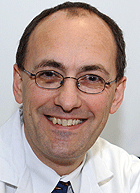Clinical studies are proving that the genetic profile of a tumor can greatly influence its response to anticancer treatments. Identifying genetic alterations in tumors could help oncologists choose the most effective of several treatment options for their patients with cancer.

Matthew J. Ellis, M.D., Ph.D., the Anheuser-Busch Endowed Professor in Medical Oncology, is conducting research that aims to use the genetic profile of breast tumors to guide breast-cancer therapy and ultimately to find new drugs to treat the disease.
“Buried in the complex genome of breast tumors is information about which treatment patients should get,” said Ellis, a breast-cancer specialist with Siteman Cancer Center. “Ideally, we would like to understand all the molecular changes occurring in these cancers and catalog them based on patients’ responses to treatments.”
As part of this far-reaching program, Ellis is engaged in a clinical trial launched by the American College of Surgeons Oncology Group. Ellis and colleagues nationwide are hoping to uncover genetic clues that help explain why giving estrogen-reducing drugs before surgery helps some breast-cancer patients more than others.
“Subsets of breast tumors express the estrogen receptor, but patients’ response to drugs that reduce circulating estrogen levels is variable,” Ellis said. “The question is: What is the molecular basis of this diversity?”
Researchers know well that estrogen can spur the growth of breast-cancer cells. Three drugs — exemestane (Aromasin), letrozole (Femara) and anastrozole (Arimidex) — fight breast cancer by lowering the amount of estrogen the body makes. Physicians participating in the trial want to find out if one of these three drugs given before surgery is more effective than another in making tumors shrink, reducing the amount of normal tissue that needs to be removed in subsequent surgery. This randomized phase III trial will enroll postmenopausal women who are undergoing surgery for stage II or stage III breast cancer.
But there’s more going on in the trial than the relatively straightforward goal of picking the best of three medications. For Ellis’ part, he wants to find genetic signposts that can someday tell physicians before treatment begins which breast- cancer patients will respond well to one of these therapies and which patients will require traditional chemotherapy to reduce their tumors before surgery.
“We’ll study the genome of each individual breast cancer in the trial and compare it with the short- and long-term outcomes of therapy,” Ellis said. “We should be able to create a genetic map or atlas that tells us the molecular basis for resistance or sensitivity to this treatment.”
To accelerate the process of discovery, Ellis said they would use a simple “trick” for measuring how a tumor removed from a breast- cancer patient is responding to estrogen-lowering drugs. Scientists can monitor a molecule called Ki67 to find out if a cell is dividing. If the estrogen-lowering therapy is effective, Ki67 diminishes or goes away. Past research has shown that when Ki67 remains high during treatment, patients are considerably more likely to have a recurrence of their cancer.
Ki67 allows researchers to find out relatively quickly which cancers are not responding to therapy and to rapidly determine genetic differences that explain tumors’ resistance to treatment.
In addition to helping guide physicians to choose the most effective therapy, Ellis wants to use such genetic information to find new anticancer therapies.
Using tumor samples from the clinical trial, Ellis will identify genes that have been copied many times in cancer cells.
“You are only supposed to have two copies of any gene,” Ellis said. “But tumors can have four, eight or even 30 copies of a number of genes involved in cancer growth. We ask which of these gains in gene copy number is associated with resistance to estrogen-lowering drugs. Once we understand that, it can become the beginning of a new treatment or a cure based on the identity of the genes that have increased copy number and cause resistance to treatment.”